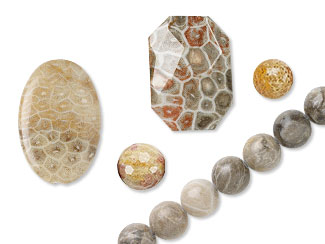

History
Fossil coral is a natural gemstone that is created when prehistoric coral is gradually replaced with agate. Corals are marine animals and it is their skeletons that are fossilized and preserved. The fossil coral forms through hardened deposits left by silica-rich waters. The entire process can take over 20 million years.
The proper name for fossil coral is “agatized coral” or “agatized fossil coral.” Agate, with its silicon dioxide composition (SiO2), is a variety of naturally occurring chalcedony–or microcrystalline quartz–rather than a type of coral. For this reason, fossil coral should not be mistaken for endangered or protected reef coral or precious coral. Fossil coral is also much harder than precious coral. Most agatized fossil coral exhibits a dull to waxy luster and interesting skeletal-like ancient coral patterns, most often appearing in flower shapes.
Fossil coral deposits are often used for the making of health and drug supplements because of their high calcium, potassium, magnesium and sodium content. Because fossil coral can remove chemical impurities such as chlorine and formaldehyde it is used in industrial fertilizers and water purification filters.
Metaphysical Properties
According to metaphysical beliefs, fossil coral is a grounding stone good for bringing about change. Agate is thought to be able to help heal pancreatic disorders and improve blood and air circulation. Fossil coral is used for healing eye, skin and stomach illnesses. It is even believed to enhance longevity.
Although coral is not a traditional birthstone for any month, it is a non-traditional zodiac stone for Taurus.
Geological Properties
Fossil coral is created through the process of calcium carbonate (coral) being replaced by silica. The silica ranges from light amorphous opaline to dense forms of chalcedony. Depending on the exact mineral concentration, fossil coral specimens can have slightly varying densities. Although the pattern and body color of fossil coral is quite distinct, it can be mistaken for other types of agate such as moss or dendritic agate.
Most fossil coral is found in Indonesia and the USA (in Florida and Georgia). Fossil coral from Indonesia is thought to be the most unique and desirable. The Florida state legislature designated agatized fossil coral as its state stone in 1979.

Comments are closed.